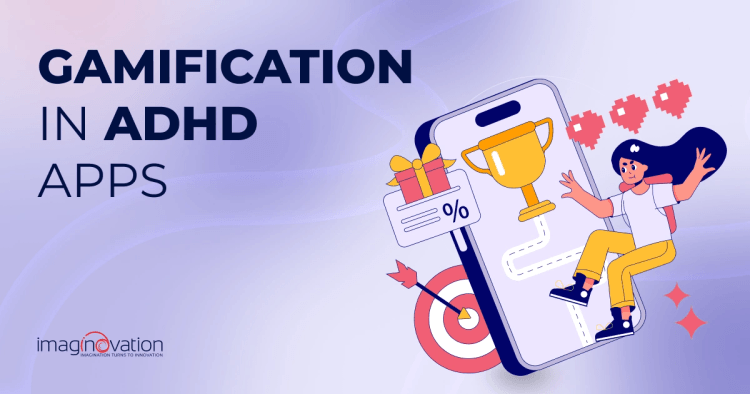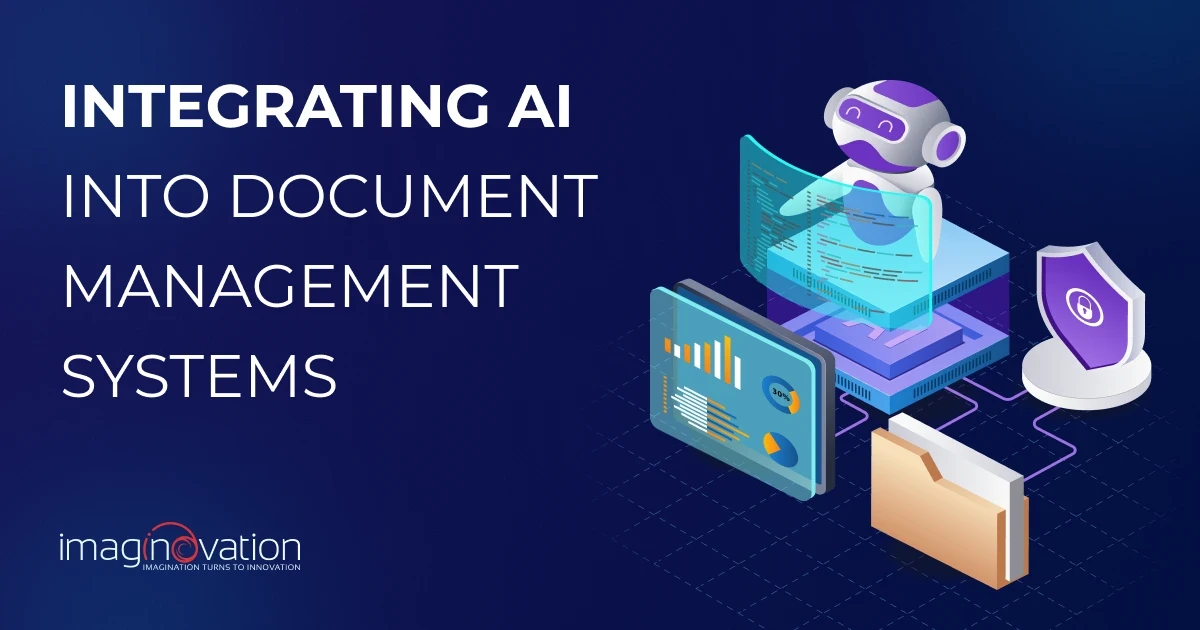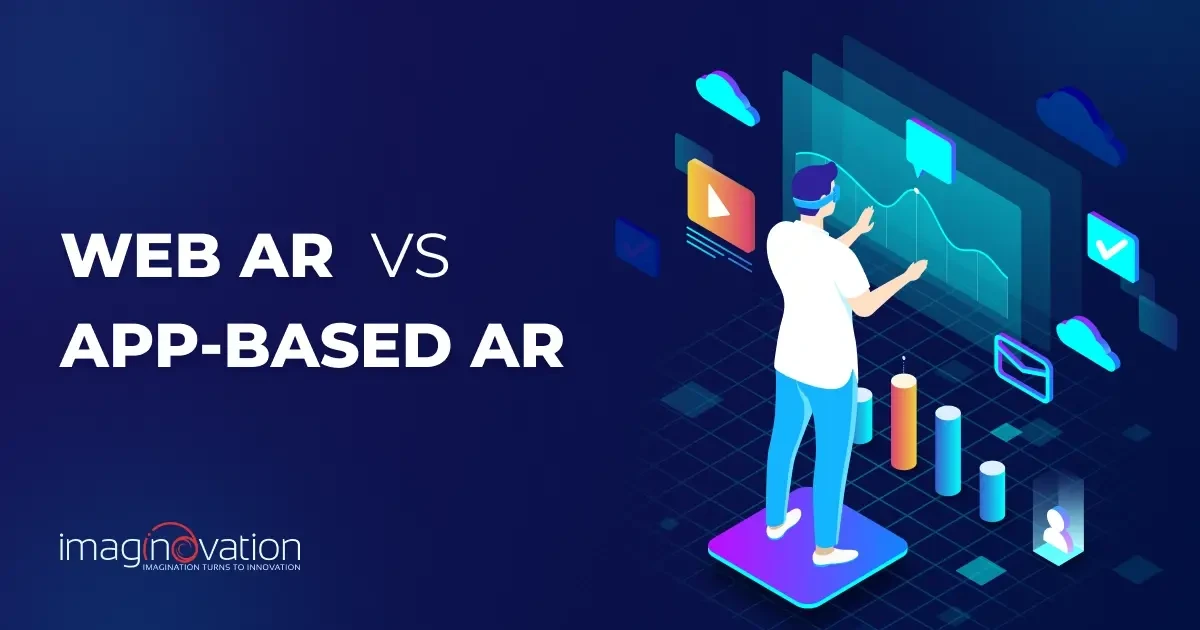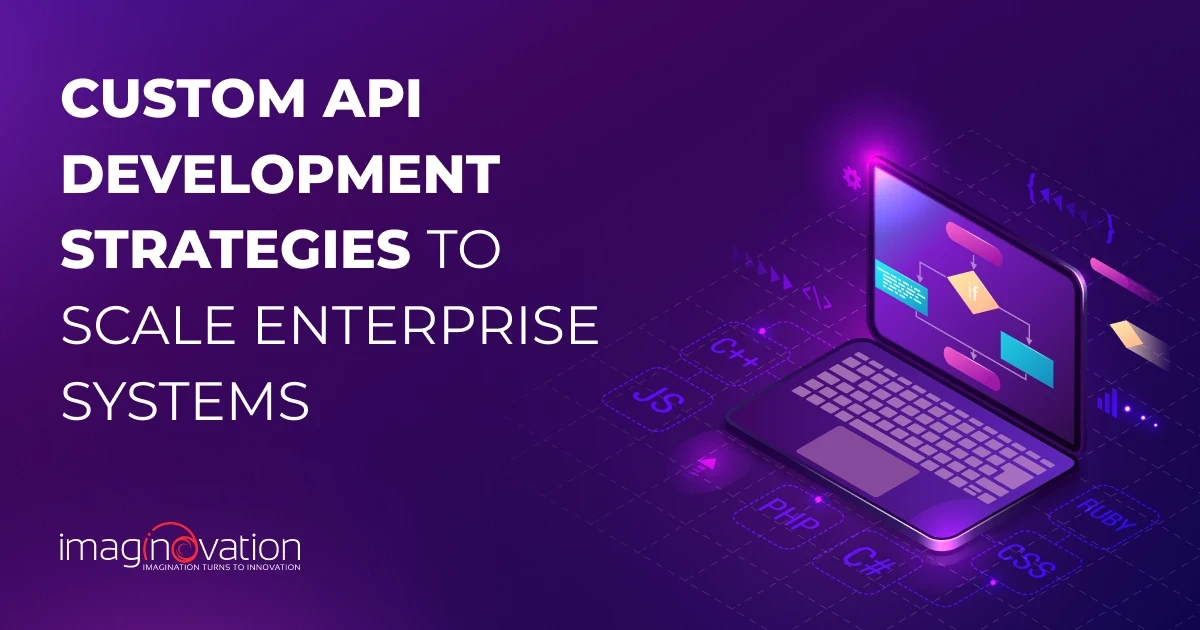Keeping users engaged with ADHD apps is tough.
Most people drop off after just a few sessions, which makes long-term retention one of the biggest challenges in this space.
It’s a problem that’s hard to ignore, especially when consistency is key to making these tools useful.
Gamification offers a way in.
When done right, it adds structure, motivation, and even a little enjoyment to the experience without turning the app into a game. And for people with ADHD, that kind of built-in feedback and momentum can make a real difference.
More healthcare teams are beginning to view gamification as a core design tool, rather than just a nice-to-have feature.
The goal isn’t to make something flashy. It’s to build an experience people actually want to return to.
Why ADHD Apps Face High Churn
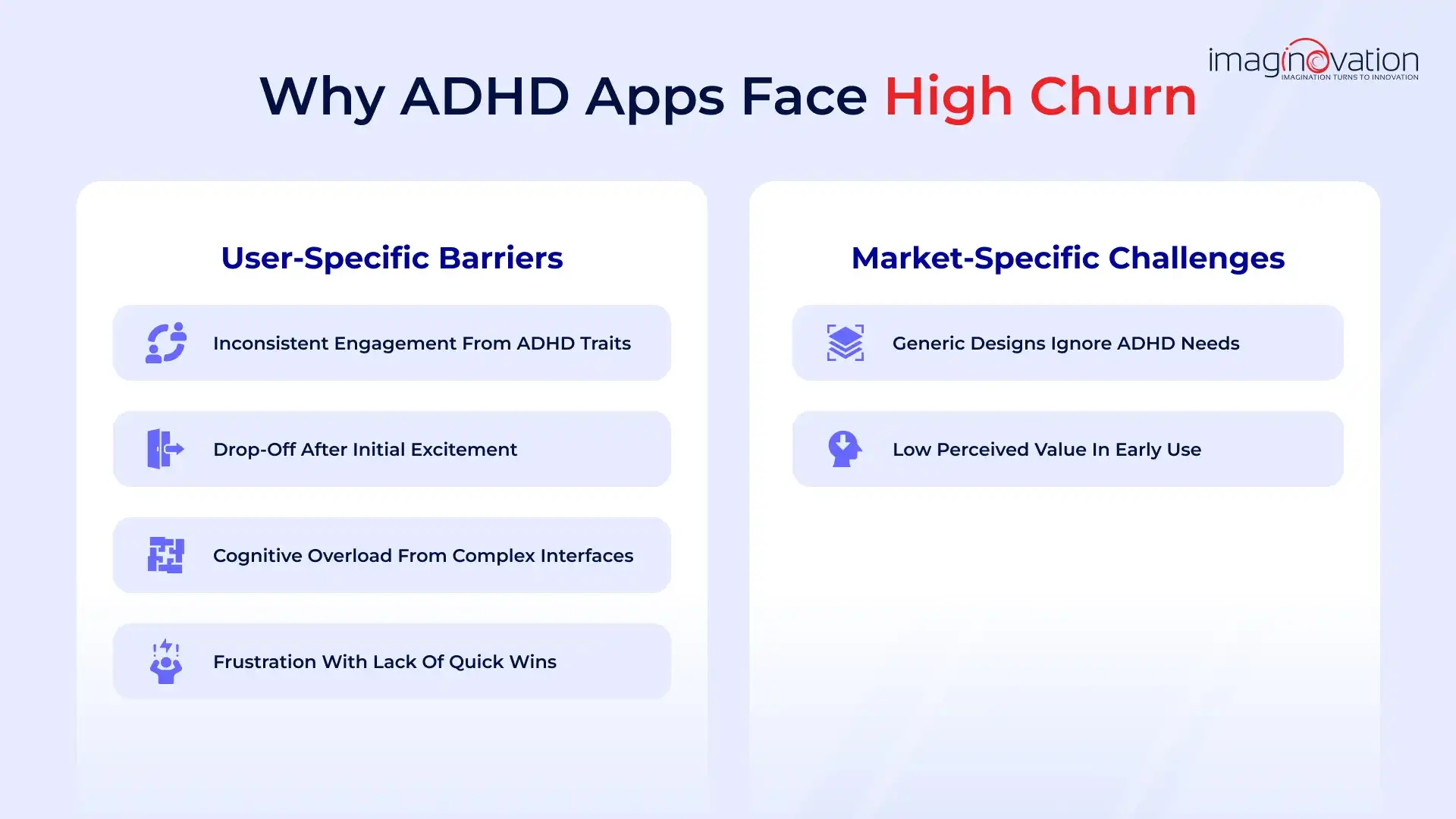
Many ADHD apps start strong but struggle to maintain user engagement over time. People download them, use them once or twice, and then drop off.
If you’re working in this space, it’s essential to understand why that happens. Some of it comes down to user-specific behavior, and some to how these tools are built.
Let’s break it down, starting with user-specific barriers.
User-Specific Barriers
1. ADHD Symptoms
ADHD symptoms like impulsivity, distractibility, and inconsistent motivation make it tough for users to stay engaged.
It’s common for someone to download an app with a burst of motivation, use it for a few days, and then forget about it. That doesn’t mean the app failed. It just didn’t align with how people with ADHD typically use digital tools.
Without something to reinforce continued use, users quickly lose interest.
Fluctuating motivation is part of the picture, and it often calls for more than just good intentions. Quick feedback and rewards can help maintain momentum.
2. Overload From Busy Interfaces
Individuals with ADHD are more likely to disengage if an app feels overwhelming. Cluttered layouts, confusing navigation, or rigid workflows can all create friction.
Apps like Notion or ClickUp can be overwhelming because they demand a lot of planning and focus right from the start.
As Pete Peranzo, co-founder of Imaginovation, puts it:
“Simplicity in UI/UX through clean interfaces, straightforward flows, and minimal clutter can make a significant difference. For users with ADHD, reducing complexity is key to improving focus and usability.”
Apps don’t need to be basic, but they do need to feel usable from the first tap.
3. Lack of Immediate Rewards
Another common issue is a lack of immediate feedback. Apps that focus solely on long-term goals often fall short of their objectives.
Many users with ADHD need early wins, some form of validation, or visible progress; otherwise, the app fades into the background.
Something as simple as a progress tracker, a visual milestone, or a well-timed nudge can make a huge difference. It’s not about tricking users into using the app, but about giving them something that feels worthwhile in the moment.
Calm, for example, is an excellent app for mindfulness, but it may not be effective for ADHD users who don’t see immediate benefits.
As Pete says:
“Anything that is rewarding is going to make someone stick to it more.”
Market-Level Challenges
Beyond user-specific behavior, there are broader design issues that contribute to churn.
4. One-Size-Fits-All Doesn’t Work
Most apps are designed for the average user, rather than those with neurodivergent needs. That often means rigid task structures, minimal visual guidance, and interfaces that require sustained focus.
For someone with ADHD, that can quickly become frustrating.
These users require more flexibility, more feedback, and tools that adapt to their working style, not the other way around.
5. Low Perceived Value Early On
Even if an app is genuinely helpful, users with ADHD might not stick around long enough to see its benefits. If the value isn’t clear in the first few sessions, chances are it won’t seem worthwhile.
They’re not looking for perfection. They’re looking for momentum. That early sense of progress can be the difference between a user staying engaged and closing the app for good.
How Gamification Addresses Retention in ADHD Apps
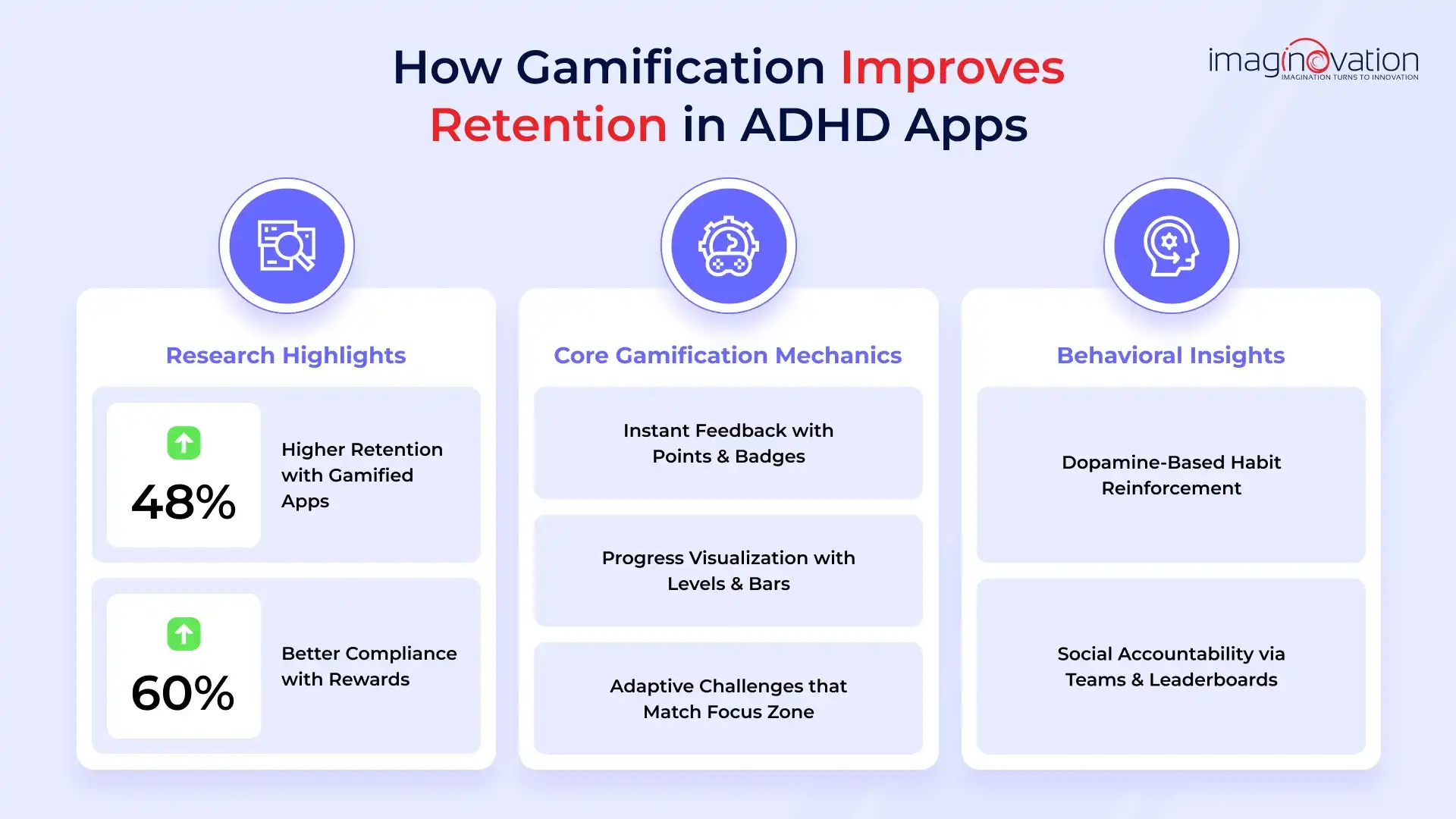
Gamification has demonstrated strong results in enhancing retention among users of ADHD apps.
A 2022 study in JMIR Serious Games found that apps with game elements had 48 percent higher retention than non-gamified ones. (source)
Another study with adolescents reported a 60 percent boost in compliance when tasks included rewards like points, badges, and streaks. (source)
Together, the data make one thing clear: when game mechanics are used well, they can make ADHD apps more effective at keeping users engaged.
Core Gamification Mechanics for ADHD
1. Instant Feedback
When rewards are delayed, ADHD users often lose interest.
Apps can work around this by offering immediate feedback, like points, badges, or encouraging messages, each time a user completes a small task. These could include activities such as journaling or tracking their mood.
Quick wins like these help reinforce habit loops. A daily streak counter, for example, can create a visual sense of consistency and give users a boost of motivation to keep going.
These small moments of success build momentum and help users stay engaged over time.
2. Progress Visualization
ADHD apps with visual progress tracking reported 31 percent higher daily active use compared to apps without this feature.
For users who struggle with time blindness or keeping track of progress over time, seeing clear visual milestones can make a big difference.
A good example is MagicTask, which utilizes dynamic progress indicators, such as tokens, leaderboards, and visual cues, to show users their progress.
These simple, consistent signals help users stay oriented and motivated, even when attention is limited.
3. Adaptive Challenges
Individuals with ADHD often seek novelty and immediate feedback.
If a task feels too hard, it can quickly become frustrating. If it’s too easy, it loses their attention. The best apps strike a balance effectively.
With AI, it’s now possible to personalize difficulty in real time. A strong example is EndeavorRx, which dynamically adjusts its in-game challenges based on the user's performance.
This approach keeps users in their optimal zone of engagement, supporting better focus over longer periods.
Behavioral Science Insights
4. Reinforcing Habits Through Dopamine Rewards
Gamified rewards like points, badges, and streaks not only keep things interesting but also tap into the brain’s dopamine system, which plays a key role in habit formation.
When users receive immediate feedback for small wins, they’re more likely to stay engaged and keep showing up.
These micro-rewards help users connect short-term effort with long-term progress. And when rewards are delivered right after the action, they can support focus and motivation in a way that feels both natural and rewarding.
5. Social Accountability
Studies show that users with ADHD who interacted with social features completed 36 percent more tasks and felt 42 percent less isolated during focus sessions.
Adding social elements, such as shared goals, team challenges, or collaborative streaks, can give users a sense of connection that strengthens their commitment.
A good example is the app Forest, where users grow virtual trees with friends while staying focused together.
Features like this turn accountability into something positive, not pressuring, but supportive.
Key Gamification Elements for ADHD App Retention
Certain gamification strategies consistently prove more effective than others in engaging users with ADHD.
Here are a few key elements backed by research and real-world results.
1. Micro-Goals and Quick Wins
Breaking tasks into smaller, manageable steps helps reduce overwhelm and makes it easier for users with ADHD to stay focused. When goals feel achievable, it’s more likely they’ll follow through.
A 2021 study in Cognitive Therapy and Research found that breaking tasks down into micro-goals improved focus duration by up to 47 percent over a four-week period.
Quick wins also trigger small dopamine boosts, which support motivation and help reduce procrastination. A good example is MagicTask, where users can break larger tasks into subtasks and check them off one by one.
These short bursts of progress often lead to longer, more consistent engagement.
2. Narrative-Driven Quests
Framing tasks as part of a larger story can turn routine actions into something more meaningful. When users feel like they’re on a mission, they’re more emotionally invested in their progress.
Stories can be simple, such as hero journeys, space quests, or unlockable levels, but they provide users with a reason to keep moving forward.
EndeavorRx is a great example.
It uses space-themed missions where children complete cognitive tasks to support a virtual crew. Each task is part of the storyline, which helps build motivation and make repetition feel purposeful.
3. Personalization
Personalized ADHD apps had 39% higher retention rates than those with a generic, one-size-fits-all design. Personalization creates a stronger sense of control and ownership, which helps users stay motivated.
Habitica is a strong example here. It allows users to create their own RPG-style avatars, set personal goals, and select custom rewards. This makes daily tasks feel more like a game, and one that actually reflects their personality and pace.
4. Daily Streaks with Escalating Rewards
Daily check-ins feel more rewarding when each one builds on the last.
For users with ADHD, this turns routine into a kind of game, something that feels active and worth coming back to. As streaks grow, so do the rewards, creating momentum and a stronger sense of progress.
Apps like Duolingo and Fabulous use streak mechanics to reward users with badges, bonuses, or unlockable content. These small wins make daily engagement feel like a satisfying ritual rather than a chore.
5. Relapse Forgiveness
Apps with relapse-forgiving mechanics had a 32 percent higher reactivation rate among ADHD users, compared to those with strict, loss-based models.
The message is simple: missing a day shouldn’t feel like failure.
Apps can ease users back in by allowing them to restore streaks through small tasks.
This approach shifts the focus from guilt to recovery, helping users re-engage without added pressure.
A good example is Fabulous, which uses messages like "It’s okay to miss a day; what matters is coming back," and offers simple ways to rebuild momentum.
6. Social Sharing and Peer Support
External validation and positive reinforcement can go a long way for users with ADHD, especially when the journey toward focus and consistency starts to feel isolating.
Features like progress sharing, in-app communities, or public goal tracking can add connection and accountability.
Apps like SuperBetter and Woebot use peer support elements to help users celebrate wins, ask for help, or simply check in with others. Turning personal progress into something shared can boost engagement and make the experience feel more meaningful.
Designing for Retention: What to Focus On
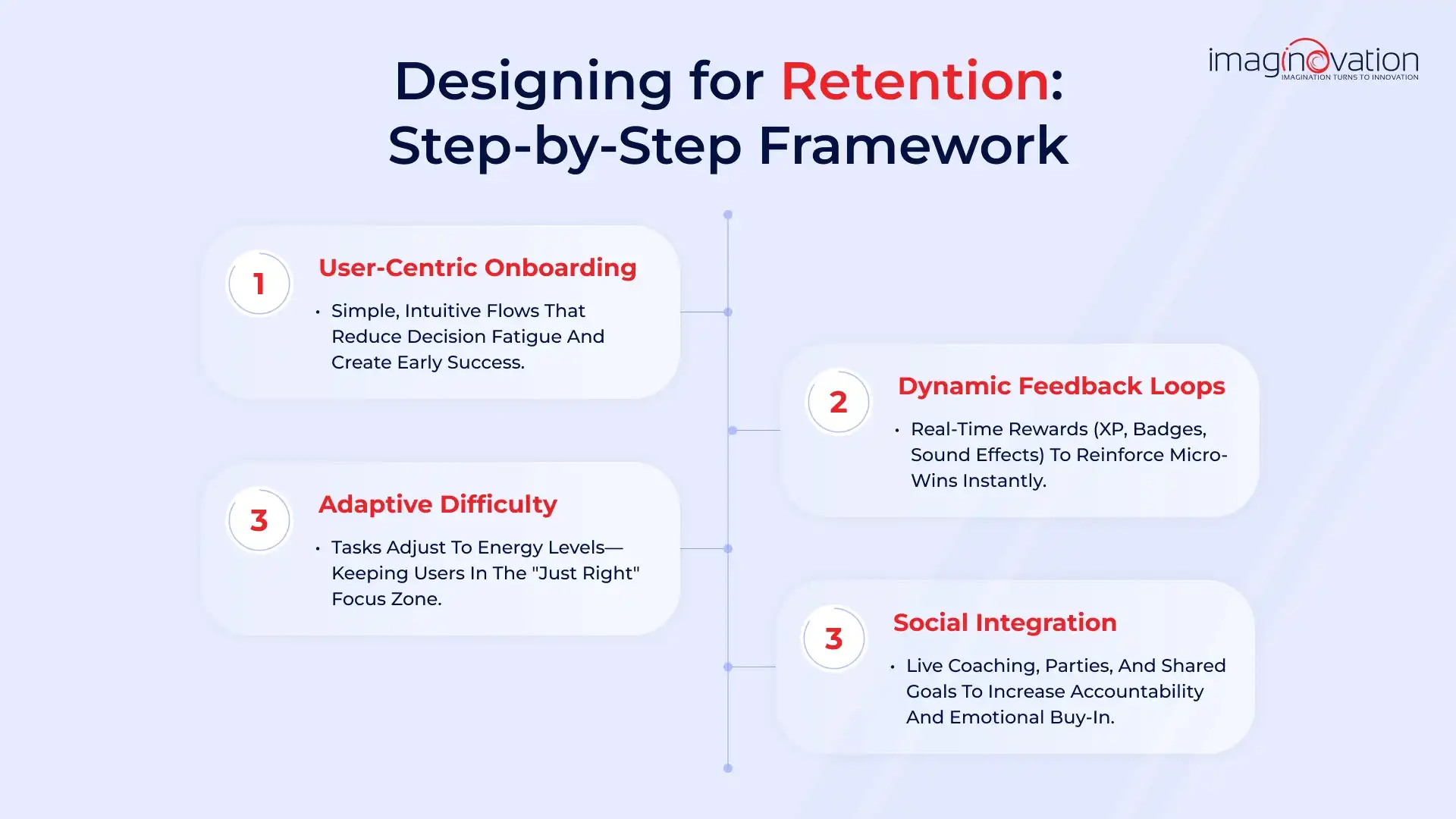
If you're building ADHD-focused apps, retention isn't just about features; it’s about removing friction, reinforcing motivation, and meeting users where they are.
Based on both research and behavioral insight, here’s what matters most:
- Simplify onboarding: Use pre-built routines or visual templates to help users get started without overthinking. The goal is early momentum, not setup fatigue.
- Deliver instant feedback: Small rewards, progress bars, or visual affirmations after each action can keep users engaged and help build habit loops.
- Adapt to user needs: Whether it’s adjusting task difficulty, session length, or notification timing, flexibility is key. One-size-fits-all rarely works for ADHD.
- Create a meaningful connection: Social elements, such as shared goals, peer challenges, or simple progress sharing, can add a sense of accountability and reduce isolation.
Before adding gamification, ensure it addresses a genuine problem.
The best-designed apps utilize these principles to support focus, build trust, and keep users coming back, because they work, not just because they’re fun.
Overcoming Common Pitfalls When Developing ADHD Apps
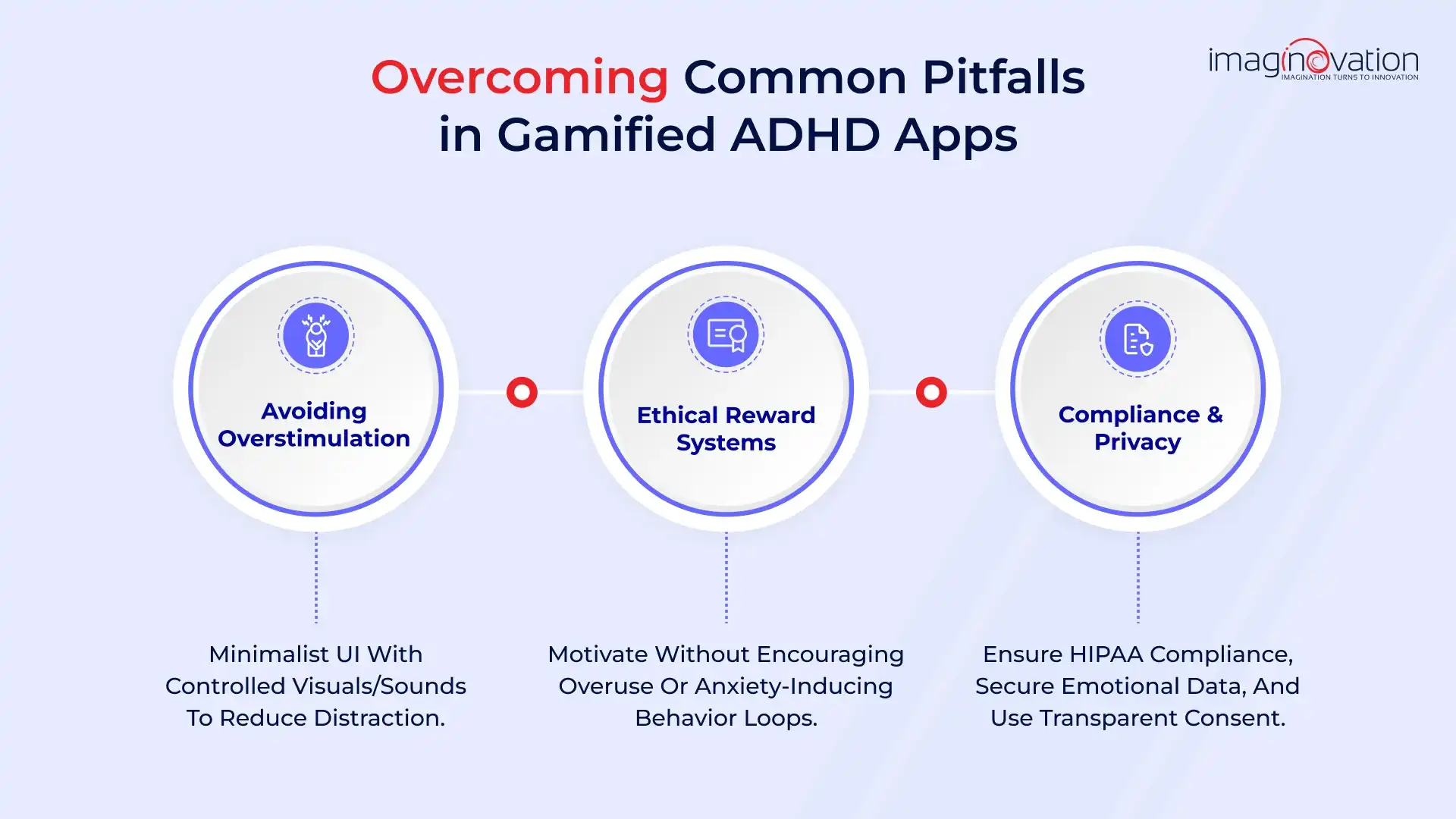
Designing gamified apps for ADHD isn’t just about adding engaging features; it requires thoughtful execution to avoid unintended consequences.
Below are a few common pitfalls and how to approach them more effectively.
1. Avoiding Overstimulation
Visual and audio feedback can help boost motivation, but excessive use can become distracting. Many users with ADHD are sensitive to overstimulation, especially when it comes to flashing visuals or constant alerts.
A more balanced approach uses clean visuals and calm interactions.
For example, Tiimo offers minimalist visual timers that support focus without adding cognitive load. Similarly, Habitica keeps things light with retro-style graphics and simple notifications that are easy to process.
2. Ethical Reward Systems
Gamification should encourage healthy engagement, not compulsive behavior. If reward systems push users to create endless tasks just to collect points, the app can contribute to burnout or anxiety.
Apps like FocusMate take a more ethical route by limiting session lengths and promoting real-world breaks. The goal is to reward consistent effort, not overuse.
3. Compliance and Privacy
ADHD apps often collect sensitive behavioral and emotional data. Developers need to take privacy seriously and ensure full compliance with regulations like HIPAA (in the U.S.).
Apps like EndeavorRx, which are FDA-approved, incorporate compliance into their design through secure data handling and adherence to medical-grade privacy standards.
For apps involving caregiver dashboards or behavioral tracking, transparent consent and strong encryption are essential to protecting user identity and trust.
Future Trends in ADHD Gamification
Let’s look at some exciting future trends.
1. AI-Powered Personalization
AI-powered gamified experiences will continue to pave the way for tailoring support for individuals with ADHD.
With AI, analyzing user behavior through predictive analytics will provide deeper insights, which will support the adjustment of difficulty levels.
Additionally, the app can recommend relevant tasks and deliver personalized rewards. These customization capabilities can help sustain engagement and accommodate unique attention patterns, ultimately maximizing the app’s therapeutic value.
2. AR/VR Integration
Another exciting trend is the rise of AR/VR technologies, which are poised to transform focus training by creating immersive, controlled environments.
To encourage sustained attention, virtual classrooms or task-specific scenarios can be designed to simulate real-life distractions, thereby enhancing the effectiveness of learning.
These experiences provide a safe and engaging way to develop executive function skills in a highly interactive setting.
3. Wearable Syncing
When wearables are integrated into ADHD gamification, they enable real-time responsiveness based on physiological data.
Information from monitoring heart rate, stress levels, or sleep quality can be fed into the app, allowing it to adapt to challenges or offer calming exercises as needed.
This biofeedback-driven approach creates a more intuitive and supportive user journey that’s grounded in the individual’s current state.
Why Choose Imaginovation for Gamification in ADHD Apps
At Imaginovation, we specialize in designing engaging, science-backed, gamified experiences tailored to the behavior of users with ADHD.
Our expert team can audit your current setup and guide you through rebuilding gamification strategies that boost retention.
With a proven approach that blends tech expertise and clinical insight, we’ll help you create an app that truly engages.
Ready to build an app, but not sure where to start?
We've got you covered. Click the button below to get started.

